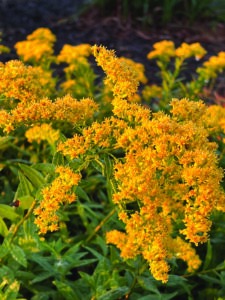
Goldenrod grows in a clump and arch up and out, imitating the look of fireworks. The bright golden yellow flowers have heavy sticky pollen that is prized by many insect pollinators. (Photo by Ginny Rosenkranz)
October’s bright blue skies are a perfect backdrop for the sunny yellow flowers of the Goldenrod.
They are native plants, but the newer cultivars like “Fireworks,” “Solar Cascade,” “Golden Fleece,” “Lynn Lowery” and “Gold Rush” are better behaved in the sunny garden.
The plants burst into flower from August to October and attracts beautiful butterflies and other pollinators to provide both color and movement into the garden.
They grow in a clump and arch up and out, imitating the look of fireworks.
The bright golden yellow flowers of Goldenrod have heavy sticky pollen that is prized by many insect pollinators.
In the gardens the native Asters with their starburst blue flowers complement the Goldenrod’s tiny daisy-like yellow flowers because their colors are on the opposite side of the color wheel, allowing both colors to pop.
Allergy sufferers may look at Goldenrod as a problem plant, but the true problem plant is ragweed, which has tiny green flowers and pollen that is so light the wind blows it 400 miles out to sea and 2 miles up in the atmosphere.
(Editor’s Note: Ginny Rosenkranz is a commercial horticulture specialist with the University of Maryland Extension.)



